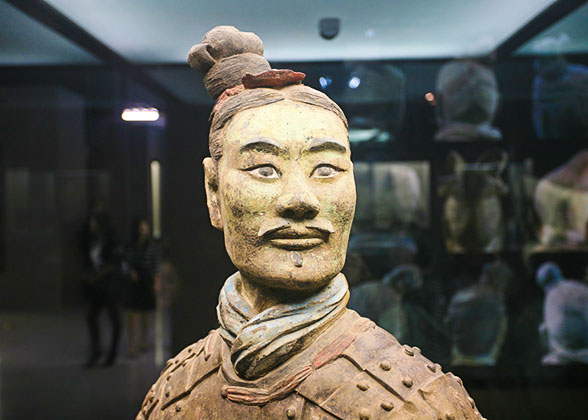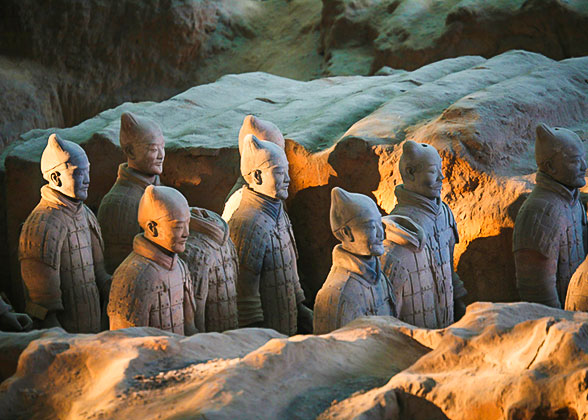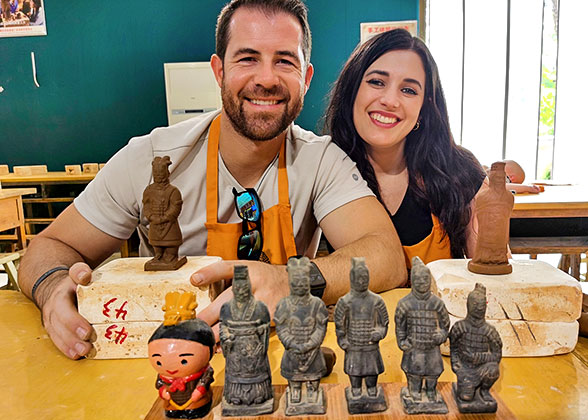2 Days Dang Village & Hukou Waterfall from Xi'an
XA39: 2 Days Xi’an Tour to Hancheng Dang Village, Confucius Temple, Hukou Waterfall & Huangdi Mausoleum
From USD289 per person Book
- Itinerary
- Prices
- Reviews
Trip Highlights
- Explore the glorious past of Dang Village from its 690-year-old residential buildings with exquisite carvings.
- Visit the third largest Confucius temple in China and discover how Chinese people pray for their academic success and careers.
- Marvel at the Yellow River pouring down to form the Hukou Waterfall, whose roaring and season-defying beauty will strike you to the core.
- Discover the origin of Chinese nation and legends of Huangdi, the mythical ancestor of Chinese people.
- No commission-based shopping stops! More time will be spent on attractions and you will enjoy a pure sightseeing tour.
- No optional tours! Optional tour is just a tourist trap and will always cost you more with a high markup on price.
This trip can be customized to meet your individual needs!
Expand All
Collapse All
Day 1 Xi'an - Hancheng - Temple of Sima Qian - Dang Village - Confucius Temple
In the morning, your guide and driver will be at your own booked hotel in downtown Xi’an on the appointed time and then drive you three hours to the 3,000-plus-year-old Hancheng, one of the most famous ancient cities in China. Get ready for a fascinating cultural tour of main attractions here!
Our first stop is the Tomb and the Ancestral Temple of Sima Qian, built in 310 AD in memory of Sima Qian, a very famous historian, litterateur, and ideologist in the Western Han Dynasty of China (202BC - 9 AD), whose historical biography, Records of the Grand Historian, played a very important role in China’s cultural history. In the temple, you will find more than 100 ancient and modern steles, which read the character and morals of Sima Qian, the historical changes of the ancestral tomb, the poetry evaluation of scholars in the past dynasties, and the famous aphorisms in his masterpiece. Located behind the temple, his tomb is built of bricks with the appearance of a yurt, atop which there is an ancient cypress. With our guide, you will discover what the cypress symbolizes.
For lunch you will explore on your own. Perhaps taste authentic local cuisine and snacks. Your guide will surely be willing to give you advice and assistance.![Ancient House at Dang Village]()
![Traditional Shoe Repair]() Then we will drive for around 40 minutes to the Dang Village, which was built in 1331 and is the largest, oldest, and best preserved ancient village in Shaanxi. Although the village is named after the surname Dang, there are actually quite a few villagers with the surname of Jia. It is just that the first inhabitants were Dang. Walking along the narrow alleys of the village, you will stroll past traditional courtyards, temples, ancestral halls and archways built with gray bricks and black tiles. There are delicate carvings decorated on the wood, stones, and bricks, revealing the village's glorious past. Auspicious symbols are everywhere, like at some yard gates, you may find two stone lions in different shapes - one has an embroidered ball under its feet and the other a lion cub, which suggest power and fertility. In some of folk houses there are also remains of small objects from ancient times, such as the travelling salesman’s box or coir raincoat, which always appears with a bamboo hat, from which you can imagine how people lived in the past. We won’t miss the Wenxing Pavilion, the tallest six-story brick tower in the village, housing the name boards of China’s highly respected literati of all ages and the statue of Kuixing God in charge of literature. With your guide’s commentaries, you would see how much the villagers value knowledge and talents.
Then we will drive for around 40 minutes to the Dang Village, which was built in 1331 and is the largest, oldest, and best preserved ancient village in Shaanxi. Although the village is named after the surname Dang, there are actually quite a few villagers with the surname of Jia. It is just that the first inhabitants were Dang. Walking along the narrow alleys of the village, you will stroll past traditional courtyards, temples, ancestral halls and archways built with gray bricks and black tiles. There are delicate carvings decorated on the wood, stones, and bricks, revealing the village's glorious past. Auspicious symbols are everywhere, like at some yard gates, you may find two stone lions in different shapes - one has an embroidered ball under its feet and the other a lion cub, which suggest power and fertility. In some of folk houses there are also remains of small objects from ancient times, such as the travelling salesman’s box or coir raincoat, which always appears with a bamboo hat, from which you can imagine how people lived in the past. We won’t miss the Wenxing Pavilion, the tallest six-story brick tower in the village, housing the name boards of China’s highly respected literati of all ages and the statue of Kuixing God in charge of literature. With your guide’s commentaries, you would see how much the villagers value knowledge and talents.
Then continue our visit to Hancheng Confucius Temple, the third largest of its kind in China. This is the place of worship for Confucius, the great Chinese thinker and founder of the Confucian school. Here you will find four large courtyards, with a total of nearly 80 rooms in the surrounding traditional quaint buildings integrating the architectural styles of Yuan (1271 - 1638), Ming (1368 - 1644) and Qing (1644 - 1911) Dynasties. One of the most spectacular ones you will see is the glazed Five-Dragon Wall (aka Wan Ren Palace Wall), which is carved with detailed auspicious clouds and five lifelike dragons, each with its own posture. On its left and right are exquisite brick koi carp reliefs, which together with the dragons symbolize the wish for scholars to be enrolled to work for the government through imperial exams. This refers to a Chinese folklore saying that when a carp jumps over a gate, it will be a dragon, which is a metaphor for achieving success. There are also many towering ancient cypress trees, among which a 1,500-year-old stands for the same blessing as koi carp is also attracting countless students to pray. Learn more interesting stories and facts about Confucius and his students from your guide while appreciating the ancient architecture.
The Confucius Temple is just located in the Old Town of Hancheng. Tonight you will stay here and wander around the old town to see the local people's traditional lifestyle and explore for some local snacks.
Accommodation: Wenyuange Merlinhod Hotel (4-star)![Carved Wooden Gate]()
![Street Vendor]()
Our first stop is the Tomb and the Ancestral Temple of Sima Qian, built in 310 AD in memory of Sima Qian, a very famous historian, litterateur, and ideologist in the Western Han Dynasty of China (202BC - 9 AD), whose historical biography, Records of the Grand Historian, played a very important role in China’s cultural history. In the temple, you will find more than 100 ancient and modern steles, which read the character and morals of Sima Qian, the historical changes of the ancestral tomb, the poetry evaluation of scholars in the past dynasties, and the famous aphorisms in his masterpiece. Located behind the temple, his tomb is built of bricks with the appearance of a yurt, atop which there is an ancient cypress. With our guide, you will discover what the cypress symbolizes.
For lunch you will explore on your own. Perhaps taste authentic local cuisine and snacks. Your guide will surely be willing to give you advice and assistance.
Ancient House at Dang Village
Traditional Shoe Repair
Then continue our visit to Hancheng Confucius Temple, the third largest of its kind in China. This is the place of worship for Confucius, the great Chinese thinker and founder of the Confucian school. Here you will find four large courtyards, with a total of nearly 80 rooms in the surrounding traditional quaint buildings integrating the architectural styles of Yuan (1271 - 1638), Ming (1368 - 1644) and Qing (1644 - 1911) Dynasties. One of the most spectacular ones you will see is the glazed Five-Dragon Wall (aka Wan Ren Palace Wall), which is carved with detailed auspicious clouds and five lifelike dragons, each with its own posture. On its left and right are exquisite brick koi carp reliefs, which together with the dragons symbolize the wish for scholars to be enrolled to work for the government through imperial exams. This refers to a Chinese folklore saying that when a carp jumps over a gate, it will be a dragon, which is a metaphor for achieving success. There are also many towering ancient cypress trees, among which a 1,500-year-old stands for the same blessing as koi carp is also attracting countless students to pray. Learn more interesting stories and facts about Confucius and his students from your guide while appreciating the ancient architecture.
The Confucius Temple is just located in the Old Town of Hancheng. Tonight you will stay here and wander around the old town to see the local people's traditional lifestyle and explore for some local snacks.
Accommodation: Wenyuange Merlinhod Hotel (4-star)
Carved Wooden Gate
Street Vendor
Day 2 Hancheng - Hukou Waterfall - Huangdi Mausoleum - Xi'an
After breakfast at hotel, let’s drive out of the Hancheng for around 2 hours to Hukou Waterfall Scenic Area in Yichuan County, Yan'an City. First, take a short shuttle bus trip from the entrance to the waterfall to officially start your exciting exploration. Hukou Waterfall, the largest yellow waterfall in the world, will take your breath away with its dramatic force and thundering roars. You will watch the majestic fall plunging down the steep cliff more than 20 meters (65.5 feet) high and the Yellow River surging forward, with vast spray of water mist filling the air to wet you and make rainbows. Its name would also interest you: Hukou, Chinese for kettle spout, refers to the narrowing estuary, into which the turbulent Yellow River rushes and causes the waterfall to “pour”. The waterfall has distinct scenery in each of the four seasons. In spring, the surrounding peach trees blossom, complementing the spectacular view of the waterfall. In summer, the powerful abundant flow makes it like countless galloping horses striking the ground. In autumn, red foliage on the hills along the banks and the yellow waterfall together form a picturesque landscape. While in winter, it loses the fury and chaos, and its surrounds become an icy crystal palace, with ice hangings like icicles and ice cascades covering the cliffs.
► Friendly Tips:
1. Due to the strong wind and heavy mist around the waterfall, it is suggested you dress yourself in a windproof and waterproof coat. Also remember to wear a pair of sunglasses and a mask to protect against the sandy and muddy spray.
2. Although the river bank of the waterfall are almost flat rock, it is covered with a layer of wet loess which makes it slippery, so you are supposed to pay more attention to safety.![Hukou Waterfall, Yan'an]()
![Local People at the Waterfall]() ► Get a Taste of Yan’an through Its Specialty Food:
► Get a Taste of Yan’an through Its Specialty Food:
We have set aside some time for you to enjoy lunch. You can either eat what you have prepared in advance or dine in a restaurant near the scenic spot. Yan’an, located in the north of Shaanxi Province boasting unique-flavored snacks at low prices, is also a paradise for eaters. You should not miss its Stir-Fried Potato Slice (Yangyu Caca), a local staple dish, and Fried Yellow Rice Pie (You Gao) with crispy skin and sugar syrup inside. If you come in summer, see that you try the cold dish Bean Jelly (Liang Fen), a must-eat for every local to dispel heat, with a sour and spicy taste very appetizing. Buckwheat Noodles (Qiaomian Hele) is also worth your taste. Ask your guide to recommend some eateries to give them a try!
After lunch, we will drive back to Xi’an. Along the way, stop to visit the Huangdi Mausoleum. Huangdi, also known as the Yellow Emperor, was considered to live 5,000 years ago. Unifying all the tribes in the Yellow River basin through a series of battles and establishing China’s first tribal alliance, he was the initiator of Chinese civilization. Today, you will pay respect to Huangdi’s tomb, monuments and altars, with your guide narrating his legends for you to delve into the dawn of Chinese civilization. We will explore all its three sections: the mausoleum, Xuanyuan Temple and Yinchi Park. Enjoy the lushness of a dense forest of evergreen cypresses around the mausoleum, with 80,000 trees in total, and wonder at the oldest cypress, 5,000 years old, said to be planted by Huangdi himself. At Xuanyuan Temple, imagine how the ancient Chinese emperors practiced rituals here to worship their ancestor - a tradition still living except the worshippers have changed to common people.![Huangdi Mausoleum]()
![Mounument at Huangdi Mausoleum]() After that, continue to transfer for around 2.5 hours to your hotel in downtown Xi’an. Your Hancheng and Hukou Waterfall tour from Xi’an has reached its end now. Thank you for traveling with us!
After that, continue to transfer for around 2.5 hours to your hotel in downtown Xi’an. Your Hancheng and Hukou Waterfall tour from Xi’an has reached its end now. Thank you for traveling with us!
Meal: Breakfast
► Friendly Tips:
1. Due to the strong wind and heavy mist around the waterfall, it is suggested you dress yourself in a windproof and waterproof coat. Also remember to wear a pair of sunglasses and a mask to protect against the sandy and muddy spray.
2. Although the river bank of the waterfall are almost flat rock, it is covered with a layer of wet loess which makes it slippery, so you are supposed to pay more attention to safety.
Hukou Waterfall, Yan'an
Local Yan'an People
We have set aside some time for you to enjoy lunch. You can either eat what you have prepared in advance or dine in a restaurant near the scenic spot. Yan’an, located in the north of Shaanxi Province boasting unique-flavored snacks at low prices, is also a paradise for eaters. You should not miss its Stir-Fried Potato Slice (Yangyu Caca), a local staple dish, and Fried Yellow Rice Pie (You Gao) with crispy skin and sugar syrup inside. If you come in summer, see that you try the cold dish Bean Jelly (Liang Fen), a must-eat for every local to dispel heat, with a sour and spicy taste very appetizing. Buckwheat Noodles (Qiaomian Hele) is also worth your taste. Ask your guide to recommend some eateries to give them a try!
After lunch, we will drive back to Xi’an. Along the way, stop to visit the Huangdi Mausoleum. Huangdi, also known as the Yellow Emperor, was considered to live 5,000 years ago. Unifying all the tribes in the Yellow River basin through a series of battles and establishing China’s first tribal alliance, he was the initiator of Chinese civilization. Today, you will pay respect to Huangdi’s tomb, monuments and altars, with your guide narrating his legends for you to delve into the dawn of Chinese civilization. We will explore all its three sections: the mausoleum, Xuanyuan Temple and Yinchi Park. Enjoy the lushness of a dense forest of evergreen cypresses around the mausoleum, with 80,000 trees in total, and wonder at the oldest cypress, 5,000 years old, said to be planted by Huangdi himself. At Xuanyuan Temple, imagine how the ancient Chinese emperors practiced rituals here to worship their ancestor - a tradition still living except the worshippers have changed to common people.
Huangdi Mausoleum
Mounument at Huangdi Mausoleum
Meal: Breakfast
Expand All
Collapse All
Tour Prices
| 1 traveler | 2-3 travelers | 4-5 travelers |
|---|---|---|
USD809 | USD459 | USD289 |
- Above prices are per person on twin sharing basis.
Price Includes
- One night hotel accommodation with breakfast
- Pick-up & drop-off from your hotel
- Professional English-speaking guide
- Private driver & air-conditioned vehicle
- Entrance fees to tourist sites
Price Excludes
- Arrival and departure flights or trains
- Personal expenses
- Entry visa fees
- Tips to guide and driver
Itineraries you may also like:



